
| KIT #: | 02213 |
| PRICE: | 25.00 Euros |
| DECALS: | Three options |
| REVIEWER: | Spiros Pendedekas |
| NOTES: |

| HISTORY |
The Su-27M was designed by the Soviet Union as a multi-role successor to the strict air defense Su-27. The first prototype made its maiden flight in June 1988. Following the dissolution of the Soviet Union, Sukhoi re-designated it as the Su-35, to attract export orders. Fourteen aircraft were produced and used for tests and demonstrations, with one example (re-designated Su-37), featuring thrust-vectoring engines. A sole Su-35UB two-seat trainer was also built in the late 1990s that resembled the Su-30MK family.
While sharing broadly the blended wing-body design of the Su-27, the Su-27M
featured canards that improved the aircraft's maneuverability. Enhancing the
already great maneuverability of the “standard” Su-27, The “M” was able to
briefly fly with its nose past the vertical, while maintaining forward momentum.
This could give the pilot a theoretical advantage as, during combat, he could
pitch the Su-27M up 120 degrees in under two seconds and fire missiles at the
target. Other notable visible changes to the stock Su-27 included taller
vertical tails and provisions for in-flight refueling. Though the first examples
retained the standard Su-27 single nose wheel, a two-wheel nose undercarriage to
support the heavier airframe was later introduced.
Besides the increase in maneuverability, another feature that distinguished the
Su-27M from the original design was the new weapons-control system, including
phased-array radar with pulse-Doppler tracking that allowed it to detect targets
below the horizon, transforming it from an air-defense fighter into a multi-role
aircraft, capable of attacking ground targets. A self-defense radar was housed
in the rearward-projecting tail boom, making the aircraft the first in the world
to have such a radar. Of interest is that the addition of the canards was
initially necessitated due to the extra front radar weight: engineers would only
later discover the aerodynamic advantages of these devices!
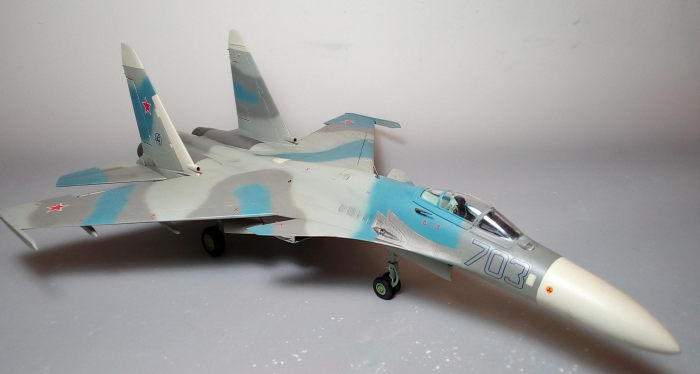 Other changes to the aircraft included the use of uprated Lyulka turbofan
engines and the increased use of lightweight composites and aluminum-lithium
alloys in the aircraft's structure. The cockpit was also modernized, becoming a
more “Glass” one. Finally, the characteristic windscreen fitted IR sensor was
moved a tad to the right, to provide better pilot visibility.
Other changes to the aircraft included the use of uprated Lyulka turbofan
engines and the increased use of lightweight composites and aluminum-lithium
alloys in the aircraft's structure. The cockpit was also modernized, becoming a
more “Glass” one. Finally, the characteristic windscreen fitted IR sensor was
moved a tad to the right, to provide better pilot visibility.
While the original Su-27M never entered mass production due to a lack of
funding, Sukhoi engineers refined the use of canards and thrust-vectoring
technology and later applied them to the Su-30MKI two-seat fighter for the
Indian Air Force. The tenth Su-27M (T10M-10) also served as a test-bed for the
Saturn AL-41FS engine that was intended for the Su-57 jet fighter.
Awaiting the development of the Su-57 program, the Su-27 remained a very capable
interim aircraft, which, though, was in almost desperate need of modernization.
Thus, in 2003, Sukhoi made a second modernization attempt. Known as the Su-35s,
this version had a completely redesigned cockpit and weapons-control system. It
featured thrust-vectoring engines in place of the canards, which were deleted,
to save weight. The dorsal airbrake was likewise deleted, with air braking
performed by differential rudder operation. The type made its first flight in
February 2008, with the Russian Air Force becoming the launch customer in 2009.
Interestingly, the Su-35s resembles the Su-27 more than the Su-27M.
One of the 14 Su-27Ms, the “703”, started its life painted at the more or less
“standard” three tone blue gray scheme. After the dissolution of the Soviet
Union it started making public appearances. Somewhere in the mid-90s, its camo
changed to a more “splinter” looking one, keeping the same color shades, with a
black “350” extra coding added to the fins at a later time. Today (as of 2021)
the “703” is a proud member of the “Russian Knights” aerobatic team, accordingly
painted!
| THE KIT |
Introduced by Mini Hobby Models (seemingly a branch of Trumpeter) in 2002, this
is more or less a “standard” Su-27B, with extra parts to account for the
external “M” differences (canards with their fuselage housings, four uninspiring
rods that are supposed to represent the thrust vectoring mechanisms and double
wheel NLG).
To say that the kit is an almost identical clone of the 1993 Academy offering,
is like saying that the Earth is round. It is practically the same kit, the most
notable difference being the absence of the PE Fret offered by Academy (mainly
including nicely perforated FOD screens, to replace the plain looking solid
styrene ones), and the vinyl tires also offered by Academy (which, to me, since
no alternative solid styrene ones are provided, is more of a disadvantage than
an advantage: the vinyl tires look more toyish than the Mini Hobby Models
provided solid styrene ones; additionally, vinyl usually eats styrene over
time).
There is some warpage and the texture of the surfaces is pebblier than the
Academy kit. Interestingly, some extra unused parts, like an extra seat,
an instrument panel and the double cockpit tub of the dual seater are provided,
so your spares dungeon can grow!
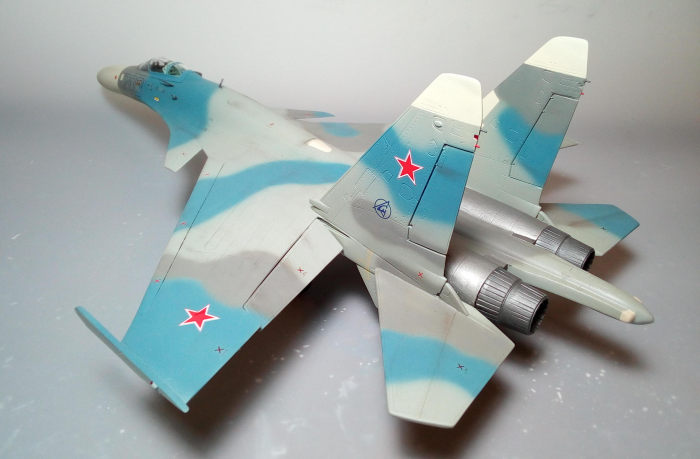 The kit comes in your typical "Trumpeter" very nice and sturdy top-opening box,
with a good boxart, depicting the thrust-vectoring Su-37 "711" flying over a
warzone, with an escorting Su-27M banking to the right. Upon opening the big
box, you are greeted with a lot of light gray plastic, for sure (after all the
Su-27 is a BIG plane)! If you are familiar with the Academy offering, then you
know what to expect: the fuselage parts are very impressive, coming in two (top
and bottom) halves, also containing the wings! Rest of the parts are provided in
four large and two small sprues. Per the Trumpeter tradition, everything is
individually sealed, packaging is just perfect.
The kit comes in your typical "Trumpeter" very nice and sturdy top-opening box,
with a good boxart, depicting the thrust-vectoring Su-37 "711" flying over a
warzone, with an escorting Su-27M banking to the right. Upon opening the big
box, you are greeted with a lot of light gray plastic, for sure (after all the
Su-27 is a BIG plane)! If you are familiar with the Academy offering, then you
know what to expect: the fuselage parts are very impressive, coming in two (top
and bottom) halves, also containing the wings! Rest of the parts are provided in
four large and two small sprues. Per the Trumpeter tradition, everything is
individually sealed, packaging is just perfect.
Cockpit representation leans towards the poor side: very simple, generic, merely
adequately detailed, could by all means benefit from some more detail, as it is
the area that firstly catches the eye at modern fighters. Moreover, whatever
representation is there is of the purely "analog" type, whereas the "M"'s
cockpits leaned towards "Glass". The complex air intakes are well appointed,
with compressor faces provided. When in the ground, the FOD screens blank them,
the kit provided solid styrene FOD screens being on the ungainly side. Slats,
flaperons, fins, stabilators, canards and the dorsal airbrake are separately
provided, should you wish to pose them “dynamically” (good luck with the slats,
more below…).
Landing gear is
nicely detailed, only missing some brake lines (I might be asking too much
now…). Though the exhausts are very nice (some more depth wouldn’t hurt…), they
are correct for the non-thrust vectoring Su-27. Full air to air ordnance is
provided (but remember: the Su-27M was supposed to be a multirole aircraft, so
some air to ground ordnance would be desirable).
Transparencies are thick but clear. The windscreen provided is not correct, as
the “M”s had the IR sensor offset to the right. Instructions are clearly
written, with, interestingly, at places Gunze and at the rest of places generic
color callouts during construction! Anyway, you can sort yourself out, since an
“explanation” table is attached.
Whereas three decal options are provided at the decal sheet (Blue 703, Black 709
and White 711), only the (very nice, I have to say) White 711 scheme is depicted
at the painting instructions. Why the equally nice 703 and 709 are not depicted,
although the relevant decals are provided, is a mystery. Decals themselves are
glossy and thin, looking good. Minimal stenciling is provided, which might be
correct for the later White 711 sand/purple demo bird, but probably incorrect
for the rest operational evaluation machines, which would normally sport at
least the typical Su-27 stenciling.
| CONSTRUCTION |
I first attached
the cockpit tub from the inside of the top fuselage part and then joined the two
fuselage parts, which, as said above, contain the wings. Fit was good in
general, but some warpage was evident to the joined wings. This was easily
remedied by applying brutal bending force at them, with glue still uncured, till
they looked straight. Be warned, this is an effective operation, but not for the
faint of heart!
I then went on and assembled the pair of 6-piece intakes. It is true that the
real FOD screens (attached at “closed” position, as it is Su-27’s normal ground
posture), have a heavy cross-wire, almost solid looking pattern. Still, I did
not like the solid styrene plain looking kit ones, so I replaced them with two
pieces of fine mesh, carefully affixed in place with cyanoacrylate glue. The
result is very nice and quite realistic, with the silver painted compressor
faces being merely (but positively) visible! The intakes bottom louvers were
also represented “shut”, by attaching the appropriate parts (“open” optional
parts are provided as well). Intake innards color was Hu64 Light Gray.
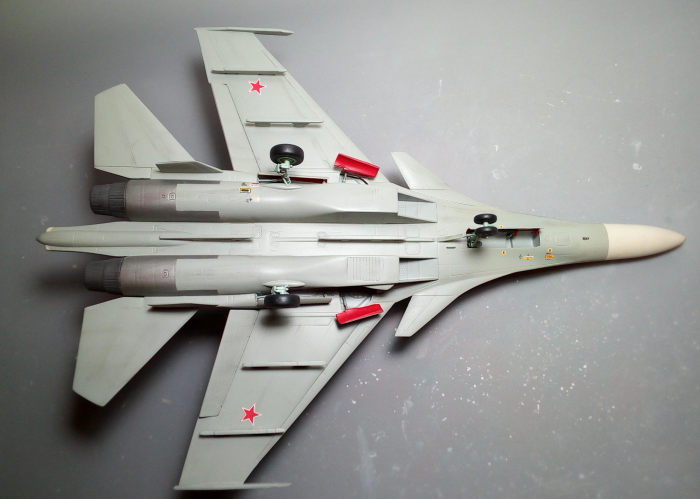 Moving on, I assembled the 2-piece slats and attached them at the wings. Fit was
not all that great there, having to shave and sand quite a bit of excess
plastic, in order to blend them with the wings. I then attached the canards at
their aerodynamic housings, which in turn were attached at the fuselage sides.
They are butt joined, so I used the scheme top view as an aid. The pair of
5-piece vertical stabilizers were assembled, attached in position and had their
front base faces drilled out, as they are supposed to be air inlets. The ventral
strakes, nose cone (no weight is needed), dashboard panel, rear antiglare cover,
airbrake and tip pylons were also attached at this point. The flaperons and rear
stabilators and were also assembled but not attached, to facilitate painting.
Fit varied from good to less good at places. Of note is that the various
trailing edges resulting thickness is off scale (thick). I counteracted it, by
thinning their innards, before putting them together.
Moving on, I assembled the 2-piece slats and attached them at the wings. Fit was
not all that great there, having to shave and sand quite a bit of excess
plastic, in order to blend them with the wings. I then attached the canards at
their aerodynamic housings, which in turn were attached at the fuselage sides.
They are butt joined, so I used the scheme top view as an aid. The pair of
5-piece vertical stabilizers were assembled, attached in position and had their
front base faces drilled out, as they are supposed to be air inlets. The ventral
strakes, nose cone (no weight is needed), dashboard panel, rear antiglare cover,
airbrake and tip pylons were also attached at this point. The flaperons and rear
stabilators and were also assembled but not attached, to facilitate painting.
Fit varied from good to less good at places. Of note is that the various
trailing edges resulting thickness is off scale (thick). I counteracted it, by
thinning their innards, before putting them together.
Continuing with subassemblies, I assembled the 2-piece exhausts, 2-piece main
wheels, the 5-piece nose and 2-piece main gear legs.
I then gave the basic model (including unattached aerodynamic surfaces and gear
doors) an initial coarse sanding, followed by filling and final 1000 sanding.
This was a quite major operation, as the challenging fit presented some serious
gaps, but in the end I was greeted with a good looking basic shape. To my joy,
sanding had eliminated the pebbly effect and had also evened the recessed
details to more realistic, subtle looking. I then attached all underside pylons
(they sport the same under-fuselage color) and took this beautiful plane to the
paint shop!
| COLORS & MARKINGS |
Thanks to the Net,
I was able to find quite a few details on those rare birds, which were initially
developed in relative secrecy and had to undergo the challenging period of the
Soviet Union dissolution. Info found included invaluable pics of “Blue 703” at
its early life, which was my chosen scheme.
Photo evidence shows “Blue 703” to be initially painted per the standard light
blue/gray/blue Su-27 policies. It has been seen sporting gray or white nose cone
and dielectric panels. I went with white, so I started by applying white (Hu130)
at these areas, then masked them off. The characteristic steel shades at the
engine and gun areas were represented by applying Testors Steel (with a mist of
Revell Clear Blue on top, at the places where Titanium was used). They were then
masked off as well.
 Taking into account that a lot of tonal variations were witnessed for the
supposedly same color shades in the Soviet Union those early years (it being
especially true for the all those light blue/bluish light gray/light blue-gray
and the like shades seen and mentioned...), I went with my own interpretation
and applied Hu65 Light Blue all over the plane. This included cockpit basic
color and the landing gear legs (more on the legs later).
Taking into account that a lot of tonal variations were witnessed for the
supposedly same color shades in the Soviet Union those early years (it being
especially true for the all those light blue/bluish light gray/light blue-gray
and the like shades seen and mentioned...), I went with my own interpretation
and applied Hu65 Light Blue all over the plane. This included cockpit basic
color and the landing gear legs (more on the legs later).
After a protective coat of Future, I proceeded by freehand airbrushing the
medium gray (Hu140) and middle blue (Hu89), roughly following the general
pattern of contemporary “normal” Su-27s. Upon finishing, I removed the masks and
sealed/glossed everything with a coat of Future.
I used the kit decals, which were thin and, to my pleasure behaved nicely.
Regarding stenciling, only the characteristic red/yellow “Опасно” intake ones
are provided. This might be applicable to some of the latest post-Soviet Union
dissolution demonstrators, but during the earlier years, stenciling did appear
to exist: I thus used a good number of leftover Su-27 stenciling, which added to
the “operational” looks of the plane a lot. A coat of future finally sealed the
decals.
| FINAL CONSTRUCTION |
The seat was
assembled and painted light blue with black cushions and red “eject” handle.
It had green doped seat belts added, made from masking tape. It was then
installed in place, together with the control stick. I was lucky enough to
have some leftover instrument panel and side console decals that more or
less resembled the “M” cockpit layout, so I cut them to shape an used them.
Stick handle and front antiglare panel were painted black (rear antiglare
retained the light blue). Red, yellow and white paint was pin-applied, to
represent various switches. The HUD transparency was then attached with
white glue. The final cockpit result, though not perfect, would be
believable under the closed canopy.
The gear doors innards were painted red and attached in place. The alcohol
tank was painted black with silver braces and attached at the nose gear
door's inner side. The three landing lights were attached at the NLG leg and
all landing gear oleos were highlighted with my Pilot silver pen. Bays basic
color was Hu64 Light Gray. All bays then received a black wash and all legs
were drybrushed with Hu56 Aluminum, which, indeed, change their looks to
bluish gray, which was my initial aim! The wheels were painted a light green
with black tires and attached as well. The nose wheel mudguard provided by
the kit was out of scale and unrefined. Since photo evidence showed the
“703” with AND without it, I happily left it apart!
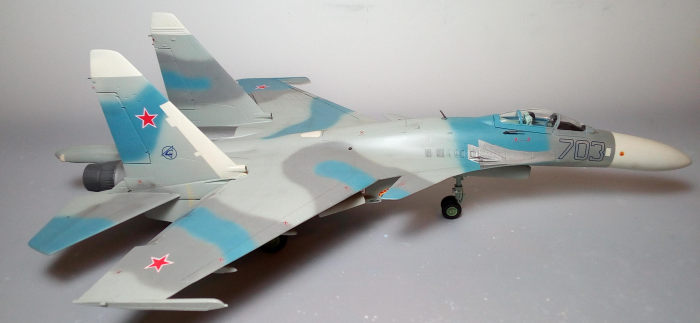 Upon engine shutdown, flaperons immediately drooped down, with the
stabilators occasionally pitching up. I thus attached the flaperons at
“down” position, but left the stabilators “neutral”.
Upon engine shutdown, flaperons immediately drooped down, with the
stabilators occasionally pitching up. I thus attached the flaperons at
“down” position, but left the stabilators “neutral”.
ALF-31 engines did not seem to sport ceramic coated nozzle innards by that
time, so I gave the whole exhaust nozzles a coating of Testors Burned Metal,
buffed their outsides and attached them in position. The various pitot/angle
of attack/aerial sensors and the gun barrel were painted gunmetal and
attached in place, as well. The very characteristic aft fins aerial tips
were painted red or steel, according to photo evidence.
As stated above, kit windscreen has the IR sensor molded at the centerline,
which is wrong for the “M”s: they had it attached offset to the right.
Having decided to fix it, I took a deep breath and carefully sawed-off the
IR sensor from the windscreen with my mini saw. I then shaved the excess
plastic from the windscreen, followed by sanding (progressively to 2000
grit) and polishing. The IR sensor’s base was then curved by judicious
sanding, in order to fit offset to the right of the polished windscreen. It
was subsequently attached at its new position with a tiny smear of styrene
glue. I will not lie: this was a nerve wracking process, paying constant
attention not to overstress and also not to irreparably scratch the
windscreen. With the plastic big thickness being my ally, the end result,
though not perfect, was acceptable, a qualitative departure from the
original windscreen wrong looks. The clear parts were then hand painted and
attached closed, the resulting gaps were faired with white glue (Tom
Cleaver’s nice advice). The “703” did not sport a nose pitot, so none was
attached.
Since it was a demonstrator/evaluation plane, most likely kept in good
condition, especially during its early days, minimal weathering was applied,
by using various dark shades of dry pastels. A coat of almost matt varnish
(80/20 matt/gloss) gave the “703” its final shine.
I then called this beautiful plane done!
| CONCLUSIONS |
The Su-27M is an iconic plane that served as basis for the improvisation of the
Su-27 family, in order to soldier well into the 21st century. The fact that only
14 were built, makes it unique!
If you want an accurate quarter scale representation of the Su-27M, the
seemingly best available option is to use the Wolfpack
WP48165 conversion set and
modify a “normal” Academy (or the clone Trumpeter) Su-27 kit. I have not used
this conversion set, but, from what I see, it looks very well done and extremely
comprehensive. Decals for only the “711” are included, but Begemot, among
possibly others, offers decal options for other Su-27Ms, so you will somehow
sort yourself out. The Wolfpack conversion is pricey (at the $90 neighborhood),
but, if you can afford it, it looks worth it. It also includes extra goodies,
like nice wheels (so you can throw away the Academy vinyl ones).
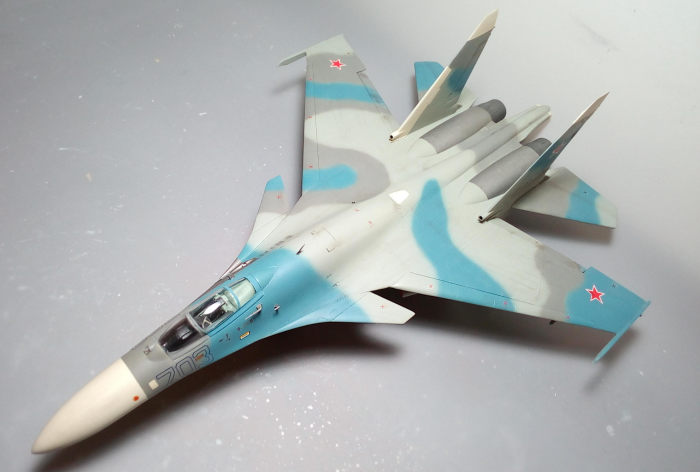 My kit was an attempt by Mini Hobby Models (ok, Trumpeter) to provide a
“mainstream” option for building an Su-27M, by providing many (but not all!) of
the extra parts required, in order to transform the standard su-27 to an “M”.
Offered at a really low price, a relatively accurate “M’ can be produced out of
the box (OOB), the most glaring inaccuracies being the non-offset IR sensor, the
analog cockpit and, should you wish to depict the thrust vectoring version, the
wrongly represented exhaust nozzles (along with a too long and bulbous
radome, Ed). That said, rest of parts basic shapes look
good, with construction presenting some fit/warp/pebbly surfacing issues that
have to be addressed. Building instructions are adequate, as are the decals
quality, but the two alternative schemes provided are not covered by the
painting instructions at all, with the Net, as usual, saving the day. With all
above said, an intermediate modeler can work his way through and come up with a
nice (but not accurate) OOB Su-27M.
My kit was an attempt by Mini Hobby Models (ok, Trumpeter) to provide a
“mainstream” option for building an Su-27M, by providing many (but not all!) of
the extra parts required, in order to transform the standard su-27 to an “M”.
Offered at a really low price, a relatively accurate “M’ can be produced out of
the box (OOB), the most glaring inaccuracies being the non-offset IR sensor, the
analog cockpit and, should you wish to depict the thrust vectoring version, the
wrongly represented exhaust nozzles (along with a too long and bulbous
radome, Ed). That said, rest of parts basic shapes look
good, with construction presenting some fit/warp/pebbly surfacing issues that
have to be addressed. Building instructions are adequate, as are the decals
quality, but the two alternative schemes provided are not covered by the
painting instructions at all, with the Net, as usual, saving the day. With all
above said, an intermediate modeler can work his way through and come up with a
nice (but not accurate) OOB Su-27M.
Per my usual mannerism, I went on modifying kit areas that diverged from the “M”
standard, with whatever I had available. It did require some extra effort
(thorough research definitely included!), but it was a really enjoyable journey.
The net result, though not a totally accurate Su-27M representation, is a quite
believable departure from the basic kit. This particular version has never ben
re-released by Mini Hobby Models/Trumpeter (and I doubt if it ever will). It can
still be found (not very easily) at the $35 region price.
Happy modeling!
| REFERENCES |
Su27flankerfamily.wordpress.com (contains truly invaluable photo reference)
1 November 2021
Copyright Modeling Madness.com. All rights reserved. No reproduction in part or in whole without express permission.
If you would like your product reviewed fairly and fairly quickly, please contact the editor or see other details in the Note to Contributors.